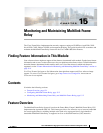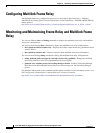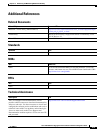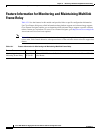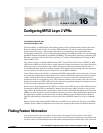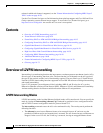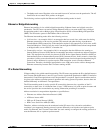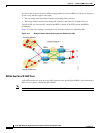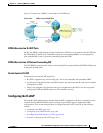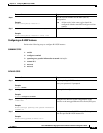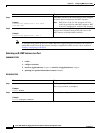
16-3
Cisco ASR 1000 Series Aggregation Services Routers Software Configuration Guide
OL-16506-17
Chapter 16 Configuring MPLS Layer 2 VPNs
Overview of L2VPN Interworking
• The ip keyword causes IP packets to be extracted from an AC and sent over the pseudowire. The AC
frames that do not contain IPv4 packets are dropped.
The following sections explain the Ethernet and IP interworking modes in detail.
Ethernet or Bridged Interworking
Ethernet interworking is also called bridged interworking. Ethernet frames are bridged across the
pseudowire. The CE routers can natively bridge Ethernet traffic or can route traffic using a bridged
encapsulation model, such as Bridge-group Virtual Interface (BVI) or Routed Bridge Encapsulation
(RBE). The PE routers operate in the Ethernet like-to-like mode.
The Ethernet interworking mode offers the following services:
• LAN services—An example of this is an enterprise that has several sites, with some sites having
Ethernet connectivity to the service provider (SP) network and others having Asynchronous
Transfer Mode (ATM) connectivity. If the enterprise requires LAN connectivity to all its sites, traffic
from the Ethernet or VLAN of one site can be sent through the IP/MPLS network and encapsulated
as bridged traffic over an ATM VC of another site.
• Connectivity services—An example of this is an enterprise that has different sites running an
Internal Gateway Protocol (IGP) that has incompatible procedures on broadcast and non broadcast
links. This enterprise has several sites that run an IGP, such as Open Shortest Path First (OSPF) or
Intermediate System-to-Intermediate System (IS-IS), between the sites. In this scenario, some of the
procedures (such as route advertisement or designated router election) depend on the underlying L2
protocol and are different for a point-to-point ATM connection versus a broadcast Ethernet
connection. Therefore, the bridged encapsulation over ATM can be used to achieve homogenous
Ethernet connectivity between the CE routers running an IGP.
IP or Routed Interworking
IP interworking is also called routed interworking. The CE routers encapsulate the IP on the link between
the CE router and the PE router. A new VC type is used to signal the IP pseudowire in MPLS. Translation
between the L2 and IP encapsulations across the pseudowire is required. Special consideration needs to
be given to the address resolution protocol operation and routing protocol operation, because these are
handled differently on different L2 encapsulations.
The IP interworking mode is used to provide IP connectivity between sites, regardless of the L2
connectivity to these sites. It is different from a Layer 3 VPN because it is point-to-point in nature and
the service provider does not maintain any routing information pertaining to customers.
Address resolution is encapsulation dependent as specified here:
• Ethernet uses Address Resolution Protocol (ARP)
• ATM us es inverse ARP
• PPP uses IP Control Protocol (IPCP)
• HDLC uses Serial Line ARP (SLARP)
Therefore, address resolution must be terminated on the PE router. Also, the end-to-end address
resolution is not supported. Routing protocols operate differently over broadcast and point-to-point
media. For Ethernet, the CE routers must either use static routing or configure the routing protocols to
treat the Ethernet side as a point-to-point network.





